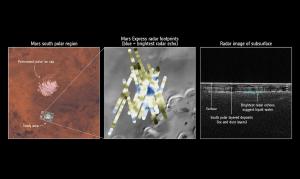Blog
Water Water Everywhere
31 July 2018
 Context map: NASA/Viking; THEMIS background: NASA/JPL-Caltech/Arizona State University; MARSIS data: ESA/NASA/JPL/ASI/Univ. Rome; R. Orosei et al 2018
Context map: NASA/Viking; THEMIS background: NASA/JPL-Caltech/Arizona State University; MARSIS data: ESA/NASA/JPL/ASI/Univ. Rome; R. Orosei et al 2018Astronomers have discovered water on Mars. We’ve heard this statement lots of time before, often with the breathless claim that the discovery of Martian life might soon follow. So should this discovery raise our hopes for life on Mars? Maybe, maybe not.
To begin with, this is an interesting discovery, and if confirmed it’s a potentially big one. Our study of the Red Planet has told us that Mars was once a warm, watery world. It had oceans of water in its early history. We also know it’s early atmosphere was rich with oxygen. So the conditions of early Mars was very favorable to life as we know it on Earth. But we also know that modern Mars is extremely dry. There is some water ice on the exposed surface of Mars, but no lakes or oceans. There’s some evidence of brine water beneath the surface, but not in large quantities. The surface of modern Mars is not a place where life is likely to thrive.
Which brings us to this latest discovery.1 We’ve known for a while that much of the Martian water is now frozen beneath the surface. There’s plenty of water on Mars, just not liquid water. One of the detectors on the Mars Express is MARSIS, which is a radar system that can bounce signals off the Martian surface. The signals penetrate the surface until they reflect off of something, typically water ice. By timing the arrival of the reflected signal, we can map stuff under the surface. While mapping Mars with MARSIS, the team found a region near the south pole that was a bit odd. It is much more reflective than other areas, which means it’s probably something different than the usual water ice. Liquid water is more radar reflective than ice, so this looks like water.
But we can’t jump to conclusions. Earth has plenty of subsurface water pockets, but Earth is geologically active and is relatively warm beneath the surface. Plenty warm for water to be liquid. But Mars isn’t geologically active, so it’s interior is cold. At the depth of this particular region, the temperature is estimated to be almost -70 degrees Celsius. That’s far to cold for liquid water, even if it’s under pressure. But this reflective region is also at the bottom of a layer of frozen ice, and that makes it look like a subglacial lake. We see this on Earth, where water builds up underneath a glacier, even at temperatures well below zero. So it really does look like liquid water. So what gives?
There is a way to liquify water, even at -70 Celsius: make it really, really salty. We know that there are various salts on Mars (perchlorates), and if those salts were highly dissolved in layers of subsurface ice, it could produce a region of briny liquid water, or perhaps a slushy briny soup. So this might be liquid water, but it would have to be really salty. Far more salty than Earth’s oceans.
So what about life? On Earth, microorganisms have been found in very salty waters, such as the dead sea. But this potential Martian lake differs in two ways. For one, its much more salty than the extreme lakes of Earth. For another, it’s extremely cold, with no clear source of heat. Even if there is liquid water there, it’s not a good opportunity for life.
But we’ve been surprised before. So if these region is confirmed to be a lake of liquid water it’s a powerful discovery, and well worth exploring further.
R. Orosei, et al. Radar evidence of subglacial liquid water on Mars Science, Vol. 361, Issue 6401, pp. 490-493 (2018) ↩︎